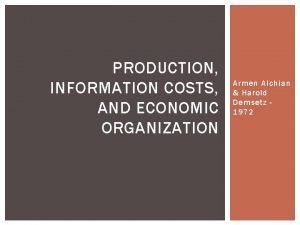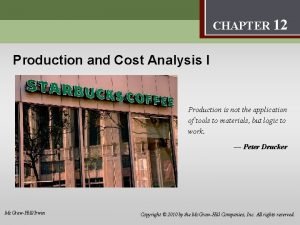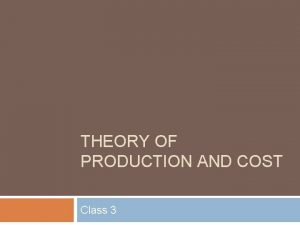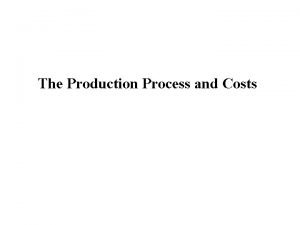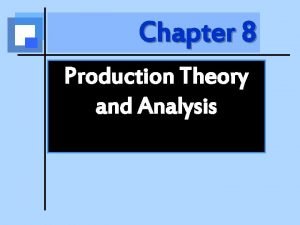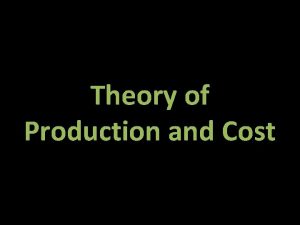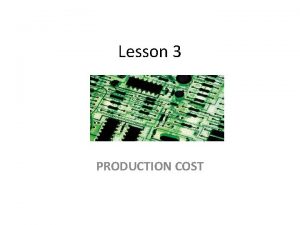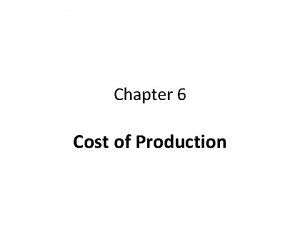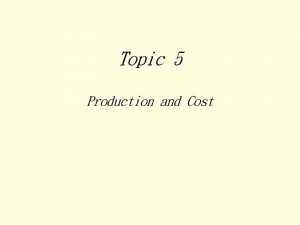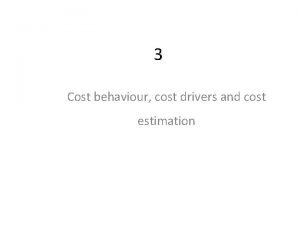Production Information Cost and Economic Organization Alchian A
















- Slides: 16

Production, Information Cost, and Economic Organization Alchian, A. A. and H. Demsetz (1972), American Economic Review, 62: 777 -795 Prepared by: Jim Downing 1

Outline Previous Seminar Literature Citations Set-up and Research Question I. The Metering Problem II. Team Production III. The Classical Firm IV. Types of Firms V. Team Spirit and Loyalty VI. Kind of Inputs Owned by the Firm VII. Firms as a Specialized Market Institutions 2

Previous Literature Citations Lajili Madunic Mahoney (2007) Asymmetric information (between principals and agents) due to team production leads to the so-called ‘‘nonseparability problem’’ (p. 347) Outcome uncertainty may be due to free-riding behavior in team production – the so-called nonseparability problem (p. 351) Positive Agency Theory Literature Anderson & Schmittlein (1984) Williamson's later writings (1981) recognize a second form of uncertainty, which he calls "internal. " Alchian and Demsetz (1972) highlight the same concept, which they call the difficulty with which individual productivity can be metered. We refer to this second form of uncertainty as the difficulty of evaluating performance. (p. 387) 3

Previous Literature Citations Popper & Zenger (1998) Still other scholars question the entire notion of a discrete make-or-buy choice, arguing instead that markets and hierarchies are points on a continuous spectrum and that the same exchange conditions (e. g. , asset specificity and measurement accuracy) which hinder market performance also hinder the performance of hierarchical exchanges (p. 854) The absence of performance-level data also makes it impossible to dismiss yet another alternative governance theory: that exchange attributes impose equal damage (or benefit) on markets and hierarchy (p. 855) In the property rights and agency theory literatures, accuracy in measuring asset values, both physical and human, defines the effectiveness of markets (p. 858) Markets succeed when they meter effectively—when they effectively link rewards to productivity (p. 858) Beginning with Alchian and Demsetz’s (1972) arguments about the equivalence of firing your grocer and firing an employee, the traditional view in agency theory has also been that the boundary distinction is of rather limited significance. If measurement difficulty damages the performance of both markets and firms (p. 859) 4

Previous Literature Citations Ouchi (1979) If equitable rewards are not forthcoming, members will, in future cooperative ventures, adjust their efforts in such a manner that all will be somewhat worse off (p. 833) Hennart (1993) costs that result from imperfect measurement. While "shirking" has generally been considered as one of those costs (p. 531) some tasks require joint effort, making it difficult to isolate individual contributions (fn. 10, p. 535) Argyes & Liebeskind (1999) This will be the case especially when uncertainty about future business conditions makes contracts incomplete and when transactions are characterized by economic spillovers, such as those that result from co-specific investments, asset indivisibility, and asset extensibility (p. 50) 5

Previous Literature Citations Mahoney (1992) Vertical financial ownership may also be an adaptive response to the agency problems of measurement uncertainty (p. 563) Asymmetric information (between principals and agents) due to team production leads to the so-called 'nonseparability problem' (p. 571) low nonseparability suggests that hierarchy is not essential (p. 575) A situation in which there is low asset specificity (i. e. , near perfect labor markets), high nonseparability and high task programmability (case 7) precisely describes the conditions posited by Alchian and Demsetz (1972). Williamson (1975: 95 -98) argues that the 'inside-contract' system (Buttrick, 1952) is the real world governance structure that most resembles the Alchian and Demsetz (1972) 'manager as monitor' model. (p. 576). Kim and Mahoney (2002) define ownership of the ‘classical capitalist firm’ in property rights terms as: (1) the right to appropriate returns from a resource (in team labor production the right to receive the residual); (2) the right to use and change the form of the resource (in the case of labor, the right to terminate or revise membership); and, (3) the right to transfer the above-mentioned rights (i. e. , alienability). (p. 226). 6

Set-up and RQ Increase Productivity Through Cooperative Specialization Example: Lumber Mill and the Cabinet Maker Cooperation between specialists achieved with a firm Cooperation across markets (or between firms) Firms Characterized by Authority, by Fiat Withholding future business Consumer-Grocer relationship is same as Employer-Employee relationship “Long-term contracts between employer and employee are not the essence of the organization we call a firm” (p. 777) RQ: “Exactly what is a team process and why does it induce the contractual form, called the firm? ” 7

The Metering Problem The firm measures (meter output) and apportions (meter control) the output of cooperative input owners seeking to maximize their comparative advantages Or put another way the firm facilitates the payment of rewards in accord with input productivity. So the problem is: Metering input productivity Metering rewards Metering of rewards and input productivity is positively correlated with output productivity Question: What makes metering difficult and hence induces means of economizing on metering costs? 8

Team Production Example: Two men jointly lifting heavy cargo; cannot determine individual contribution so the output is yielded by the team. Team production is when several types of resources (not solely owned) are used by input owners producing a collective output. Team production makes it difficult to meter input productivity, which will induce means of economizing on metering costs (i. e. , university office supplies) Team member shirking occurs when there is a lack of metering allowing for an adjustment of work reflecting: a marginal rate of substitution between leisure and production output to a marginal rate of substitution in consumption 9

Team Production Team production will be used if it yields an output enough larger than the sum of separable productions to cover the costs of organizing and disciplining team members Each input owner will have more incentive to shirk when he works as part of a team since costs must be incurred to monitor each other Forms of organizing team production to lower the cost of detecting performance (i. e. , marginal productivity) Market competition will replace excessively shirking members (overpaid), determine team members and individual rewards 10

The Classical Firm One method of reducing shirking is for someone (inspectorsteward or supervisor manager) to specialize as a monitor to check the input performance of team members. Ownership (employer) of the classical capitalist firm has ‘rights’ to resolve the shirking-information problem of team production. Measuring output performance Apportioning rewards Observing the behavior of inputs as means of detecting or observing their marginal productivity Giving assignments or instructions in what to do and how to do it Authority to terminate or revise contracts 11

The Classical Firm Two necessary conditions for the emergence of the firm It is possible to increase productivity through team-oriented production, in which it is costly to directly measure the marginal outputs of the cooperating inputs and hence it is difficult to restrict shirking through simple market exchange It is economical to estimate marginal productivity by observing or specifying input behavior The simultaneous occurrence of both conditions leads to the classical capitalist firms with, (a) Joint input production (b) Several input owners (without this, it is a socialist firm? ) One party (c) who is common to all the contracts of the joint inputs, (d) who has rights of renegotiate any input’s contract independently of contacts with other input owners, (e) who holds the residual claim, and (f) who has the right to sell his central contractual residual status 12

The Classical Firm Coase does not address metering and shirking costs Coase suggests employee open ended contracts versus a series of short-term or indefinite contracts “Alternative forms for organization of the firm are difficult to resolve on the basis of market transactions costs only. ” Knight suggests more risk-adverse inputs become employees rather than owners. “Risk adverseness and uncertainty with regard to the firm’s fortunes have little , if anything, to do with our explanation…” (p. 784) A firm is organized when policing is needed in joint team production 13

Types of Firms Types of firms Roles Main characteristics Profit-sharing firms/ partnership To encourage self-policing - Small team size - the productivity of a team member is difficult to correlate with his behavior - i. e. , artistic or professional work Socialist firms Residual sharing by employees - Need management technique to reduce shirking by the central monitor - Employee committee Corporation To acquire initial capital cheaply - Need to cope with the shirking problem caused by profit sharing among stockholders - Transferring decision authority to a smaller group Mutual and Nonprofit firms Nonprofit corporations, colleges, churches, mutual saving banks. -The future consequences of improved management are not capitalized into present wealth of stockholders - Greater shirking Employee union To monitor employer shirking for employees - Some forms of employer performance are less easy to meter; i. e. , contingent payment such as insurance or retirement pension 14

Firms as a Specialized Market Institution Opportunities for profitable team production by inputs already within the firm may be ascertained more economically and accurately than for resources outside the firm. Efficient production with heterogeneous resources is a result not of having better resources but of knowing more accurately the relative productive performances of those resources The firm is a specialized surrogate for a market for team use of inputs; it provides superior collection and collation of knowledge about heterogeneous resources. 15

Conclusions The classical firm is a contractual structure between input owners (employees) and central agent (employer). The contractual structure arises as a means of enhancing efficient organization of team production. As a consequence of the flow of information to the central agent, the firm takes on the characteristic of an efficient market in that information about the productive characteristics of a large set of specific inputs is now more cheaply available. Inputs compete with each other within and via a firm rather than solely across markets as conventionally conceived. The firm is a device for enhancing competition among sets of input resources as well as a device for more efficiently rewarding the inputs. The firm can be considered a privately owned market; if so, we could consider the firm and the ordinary market as competing types of markets. 16
 Production, information costs, and economic organization
Production, information costs, and economic organization Production information costs and economic organization
Production information costs and economic organization Membuat alur proses produksi multimedia
Membuat alur proses produksi multimedia Prof. meier and baldwin
Prof. meier and baldwin Production and cost analysis
Production and cost analysis Fixed cost
Fixed cost Cost of production
Cost of production Block arrangement essay
Block arrangement essay Economic growth vs economic development
Economic growth vs economic development Lesson 2 our economic choices
Lesson 2 our economic choices Economic region of production diagram
Economic region of production diagram Economic region of production diagram
Economic region of production diagram Marginal rate of technical substitution formula
Marginal rate of technical substitution formula Marginal rate of technical substitution
Marginal rate of technical substitution Economic production quantity formula
Economic production quantity formula Cost accumulation and cost assignment
Cost accumulation and cost assignment Cost accumulation and cost assignment
Cost accumulation and cost assignment
